Introduction
In a world where efficiency is paramount, organizations are turning to Robotic Process Automation (RPA) as a transformative solution to streamline operations and drive growth. By harnessing the power of software bots, companies can automate repetitive tasks that once consumed valuable human resources, paving the way for enhanced accuracy and faster turnaround times. From invoice processing to customer service, RPA is reshaping the landscape of business operations, enabling teams to focus on strategic initiatives rather than mundane chores.
As organizations navigate the complexities of integrating RPA with artificial intelligence, they unlock new levels of operational efficiency and informed decision-making. This article delves into the multifaceted impact of RPA, exploring its transformative use cases across various sectors and the future trends that promise to revolutionize the way businesses operate.
Understanding Robotic Process Automation (RPA) and Its Business Impact
Robotic Process Automation (RPA) refers to the use of software robots or ‘bots’ to automate repetitive and rule-based tasks typically performed by humans. This powerful tool can streamline business processes, reduce operational costs, and significantly enhance efficiency. By utilizing RPA, companies can explore several RPA use case examples to automate routine tasks such as:
- Entry of information
- Invoice handling
- Customer service inquiries
This leads to quicker turnaround times and enhanced precision.
A compelling case study from a mid-sized company serves as one of the RPA use case examples that illustrate how RPA led to a remarkable 70% reduction in data entry errors and an 80% increase in workflow efficiency. However, integrating RPA with tailored AI solutions is crucial for enhancing decision-making capabilities. These AI solutions can offer deeper insights and further enhance processes, enabling companies to stay competitive.
Additionally, businesses often face challenges during technology implementation, such as:
- Resistance to change
- The need for staff training
Addressing these challenges is essential for successfully leveraging RPA and AI together. The impact of RPA is profound; it not only optimizes workflows but also fosters innovation by freeing up employees to engage in higher-value activities, ultimately driving business growth.
In today’s rapidly evolving AI landscape, the combination of RPA and tailored AI solutions will empower your entity to achieve greater operational efficiency and informed decision-making.
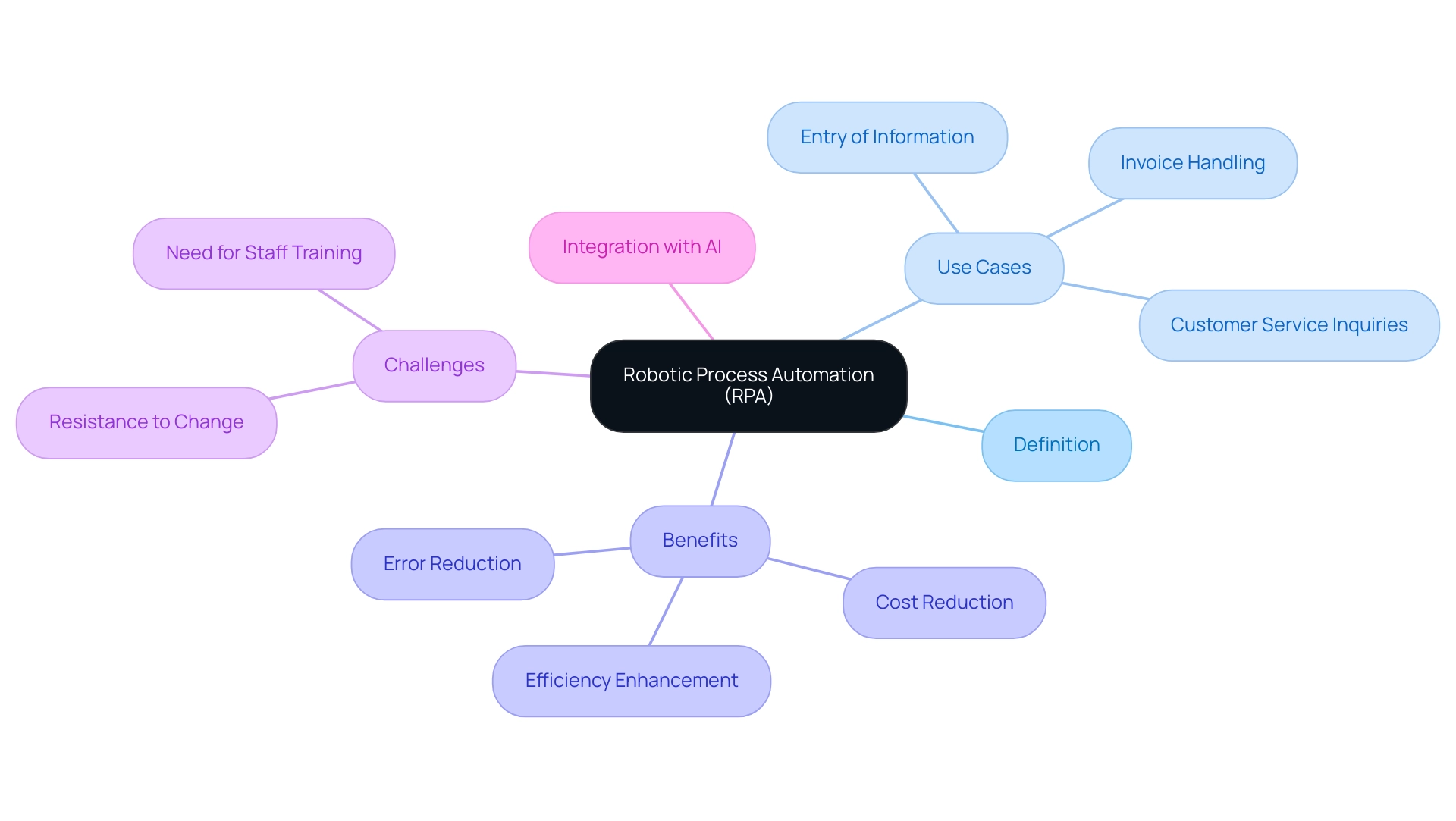
Transformative RPA Use Cases in IT: A Closer Look
-
Automated Information Migration: Automating information migration is a prevalent application of Robotic Process Automation (RPA) and serves as one of the key RPA use case examples within IT, especially during system upgrades or integrations. By deploying innovative tools like EMMA RPA and Microsoft Power Automate to facilitate the transfer of information from legacy systems to modern platforms, organizations can significantly reduce downtime and minimize errors, leading to a seamless transition. This system not only conserves valuable time but also enhances the accuracy of data, ensuring that information remains reliable throughout the migration process. The RPA market is anticipated to attain $50.50 billion worldwide by 2030, highlighting the increasing significance of intelligent systems in these processes.
-
Incident Management: RPA use case examples illustrate how it can revolutionize incident management by streamlining processes such as ticket creation and resolution. By automating the monitoring of systems for issues, bots can generate tickets and execute predefined scripts to address common problems. This leads to faster response times and alleviates the workload on IT teams, allowing them to focus on more complex challenges. As Alan Hester, president of Nividous, notes, ‘RPA is a proven solution for enhancing operational efficiency and addressing real-world business challenges.’
-
User Provisioning: The mechanization of user provisioning processes is an important RPA use case example, enabling IT departments to effectively manage user accounts and access rights. By automating the onboarding process, bots can create user accounts across various systems and assign the necessary permissions. This not only enhances operational efficiency but also bolsters security and compliance, ensuring that access is appropriately controlled.
-
Report Generation: RPA use case examples demonstrate its ability to automate the generation of IT reports by extracting data from diverse sources and compiling it into standardized formats. This system not only saves time but also ensures the consistent and precise generation of reports, offering valuable insights that inform decision-making processes.
-
Software Testing: In the realm of software development, RPA use case examples illustrate how it can play a crucial role by automating repetitive testing tasks. Bots are capable of executing test cases, logging results, and reporting defects, which significantly reduces the time required for testing cycles and enhances software quality. This system enables faster releases and enhanced reliability in software products.
-
Case Study – Eyecare Practice: This eyecare practice serves as an example of RPA use case examples by automating its claims processing using the Nividous platform. This initiative saved over 37,000 hours annually and reduced the claim-to-cash time period by nine days, demonstrating the tangible benefits of RPA in real-world applications. By implementing such solutions, businesses can overcome the challenges posed by outdated systems, such as inefficiencies and high error rates, and achieve enhanced efficiency and productivity. RPA directly addresses task repetition fatigue and staffing shortages, enabling companies to optimize their workforce and concentrate on strategic initiatives.
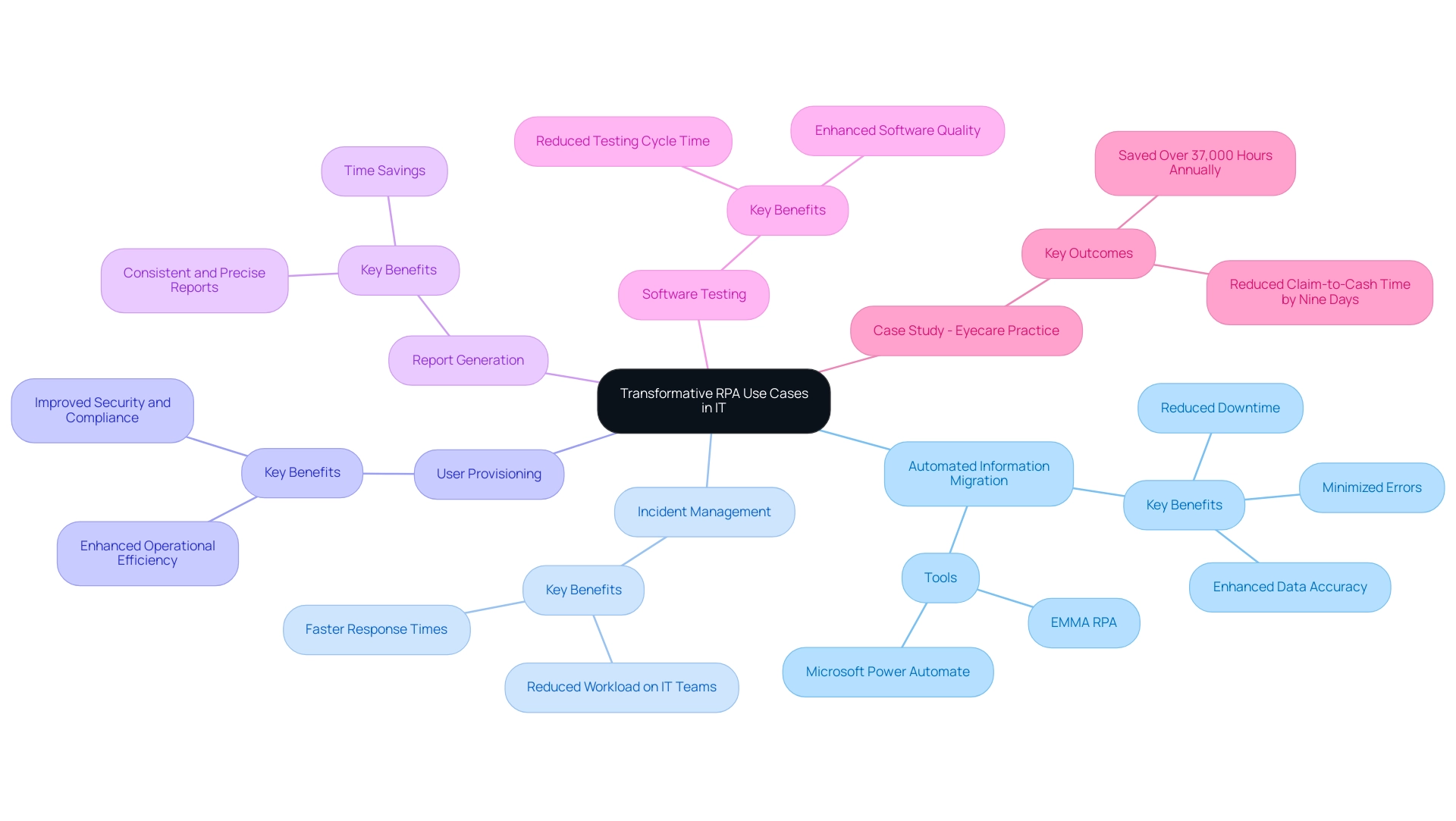
Enhancing Customer Service through RPA
-
Chatbots for Customer Support: The integration of RPA with AI-powered chatbots is revolutionizing customer support by efficiently managing inquiries. These advanced bots provide instant responses to frequently asked questions, schedule appointments, and troubleshoot common issues, drastically reducing wait times and operational costs. Companies are witnessing significant improvements in customer satisfaction levels as a result. According to a recent survey, 98% of IT leaders believe that RPA use case examples for automating business processes, such as customer support, are essential for driving substantial business benefits and reducing operational expenses.
-
Order Processing Automation: Streamlining order processing workflows through RPA is a game changer for operational efficiency and cost reduction. By automating the entry of customer orders into the system, bots can seamlessly extract order details from emails or online forms, validate this information, and update inventory systems. This automation not only accelerates order fulfillment but also enhances accuracy, minimizing the risk of errors. Real-world implementations and RPA use case examples have shown that RPA contributes to a remarkable 40% increase in overall operational efficiency, with a return on investment typically realized within six months, demonstrating significant cost savings.
-
Feedback Management and Compliance Reporting: RPA plays a crucial role in automating the collection and analysis of customer feedback, empowering businesses to proactively address customer needs. By gathering feedback from various channels and compiling it into comprehensive reports, RPA enables teams to respond to critical issues swiftly. This capability ensures continuous service quality improvement, fostering a customer-centric approach that drives loyalty and satisfaction. Additionally, as compliance requirements grow, RPA use case examples illustrate how RPA aids entities in monitoring adherence to regulations, particularly in compliance reporting. This helps reduce the risk of fines or breaches and expedites compliance processes, as highlighted in case studies where RPA has effectively monitored compliance requirements as organizations scale. Furthermore, RPA can help modernize outdated systems, ensuring that businesses remain competitive and responsive to changing market demands.
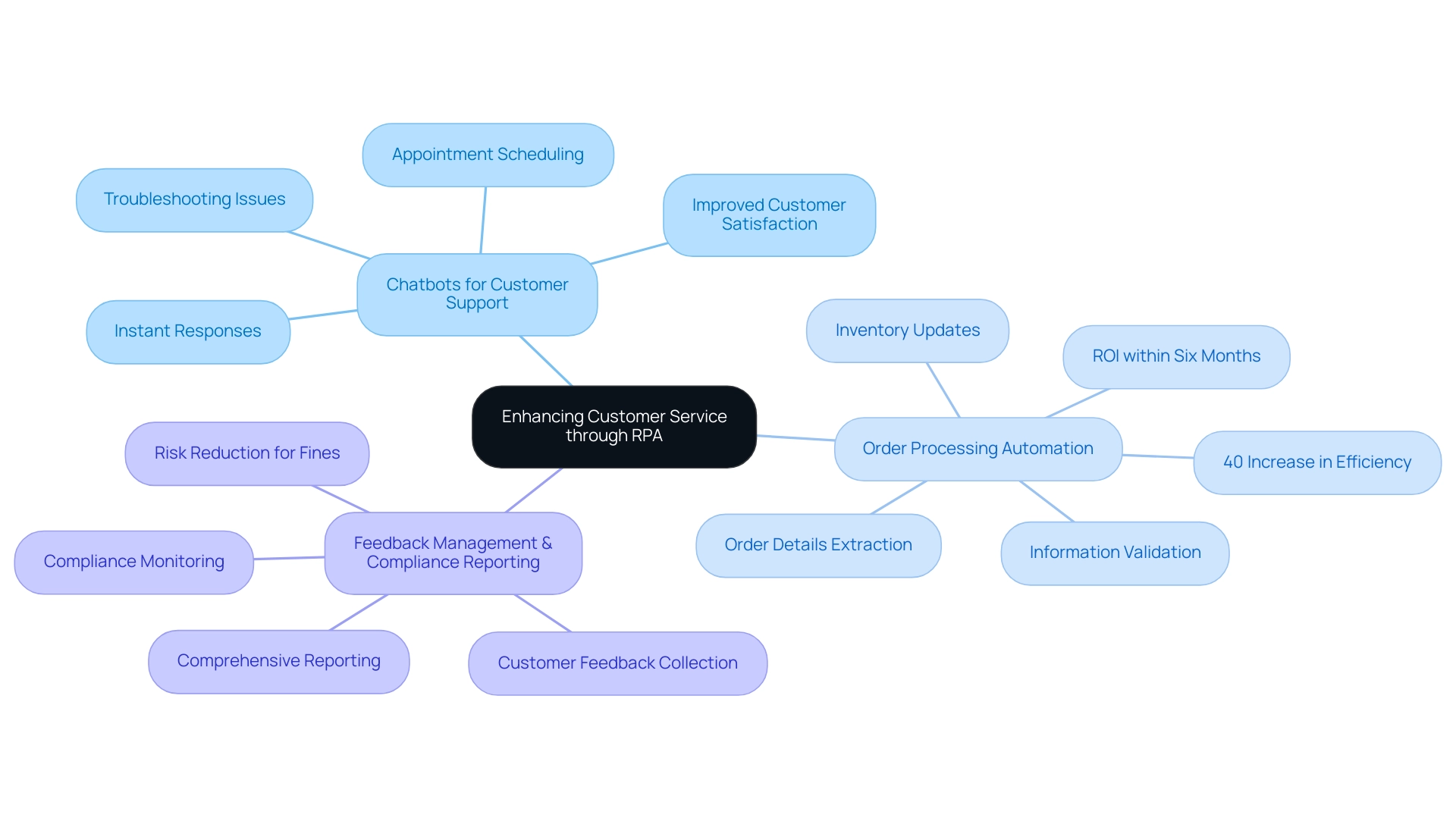
RPA in Finance: Streamlining Processes
-
Invoice Processing: RPA transforms the invoice processing workflow by automating tasks from information extraction to final approval. Intelligent bots can efficiently read invoices, validate data against purchase orders, and seamlessly route them for approval. This automation not only significantly reduces processing time but also minimizes the likelihood of errors. A notable example of RPA use case examples is SMC, which achieved an impressive 70% touchless ratio in their invoice processing within just four months of deploying RPA. Furthermore, the Aberdeen Group highlights the potential for companies to cut up to 65% of invoicing costs and reduce processing times by an average of 12 days simply through the adoption of automated invoice solutions. By redistributing administrative resources, entities can enable staff to concentrate on strategic tasks instead of manual information entry, thus improving overall productivity. Additionally, leveraging Business Intelligence through RPA can provide insights that drive data-driven decision-making, further optimizing financial processes.
-
Expense Management: The automation of expense report processing enables organizations to streamline reimbursements and enhance compliance with internal policies. RPA can extract information from receipts, categorize expenses, and route reports for approval, ensuring timely payments and adherence to company guidelines. This efficiency not only accelerates the reimbursement process but also improves employee satisfaction by minimizing delays. Furthermore, automated invoice processing software often includes built-in analytics capabilities that provide insights into cash flow and budgetary requirements, which are important RPA use case examples that support better financial strategies and informed decision-making for future business planning.
-
Regulatory Compliance: RPA plays a critical role in ensuring adherence to financial regulations by automating information collection and reporting processes. Bots can systematically gather necessary documentation and generate compliance reports, thereby reducing the risk of human error and enhancing audit readiness. When selecting invoice processing software, it is essential to take into account factors such as scalability, integration with existing tools, advanced functionality, and security measures to ensure successful implementation. Addressing these technology implementation challenges is vital for maximizing the efficiency and effectiveness of RPA solutions.
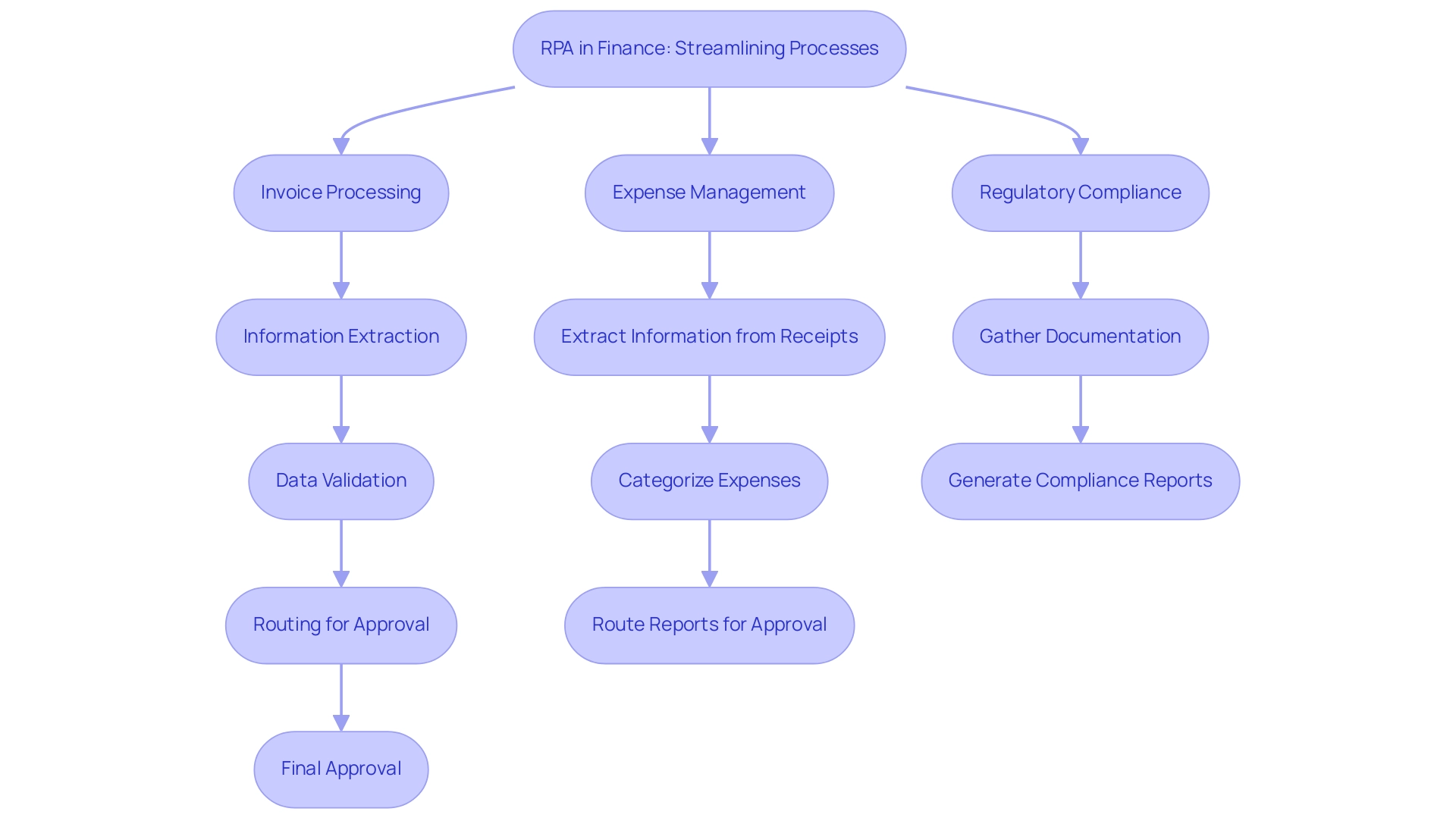
Future Trends in RPA Adoption
-
Integration with AI and Machine Learning: The future of Robotic Process Automation (RPA) is increasingly intertwined with AI and machine learning technologies. This powerful integration enables bots to examine information patterns, learn from prior actions, and make informed decisions independently. As Michał Rejman, Chief Marketing Officer at Flobotics, states,
For Sicoob, the objective of RPA implementation was threefold: to reduce errors, save time, and free up employees so that they can focus on high-value tasks.
Such capabilities not only enhance operational efficiency but also significantly reduce reliance on human intervention, allowing teams to concentrate on strategic initiatives. Moreover, the incorporation of AI enhances RPA’s ability to monitor and schedule regular backups, which is crucial for improving security and ensuring easy recovery. This integration exemplifies how tailored AI solutions can help navigate the rapidly evolving AI landscape, ultimately driving business growth and innovation. -
Increased Focus on Analytics: With the growing adoption of RPA, organizations are placing a heightened emphasis on analytics to gauge the success of their efficiency initiatives. By utilizing comprehensive information insights, businesses can enhance their processes, assess performance metrics, and reveal new opportunities for mechanization. This data-driven approach facilitates continuous improvement and empowers teams to make informed decisions that drive efficiency and productivity, underscoring the importance of Business Intelligence in any automation strategy.
-
Expansion into New Industries: Historically, RPA use case examples have been primarily found in sectors like finance, HR, and IT. However, its reach is set to expand into new industries, including healthcare and manufacturing, which will provide numerous RPA use case examples. As organizations acknowledge the substantial advantages provided by RPA—such as Sicoob’s reported 10-20% cost savings from automating information entry—they are eager to automate diverse processes across various functions. A practical example of this is the case study titled ‘Automated Data Backup and Recovery,’ which demonstrates how RPA can monitor and schedule regular data backups, ensuring easy recovery and enhancing data security. Furthermore, as businesses navigate the complexities of the AI landscape, they often struggle to identify the right tailored solutions that align with their specific needs. This trend will foster widespread adoption and innovation as companies embrace RPA to enhance their operational capabilities, ultimately leading to improved employee morale and operational success.
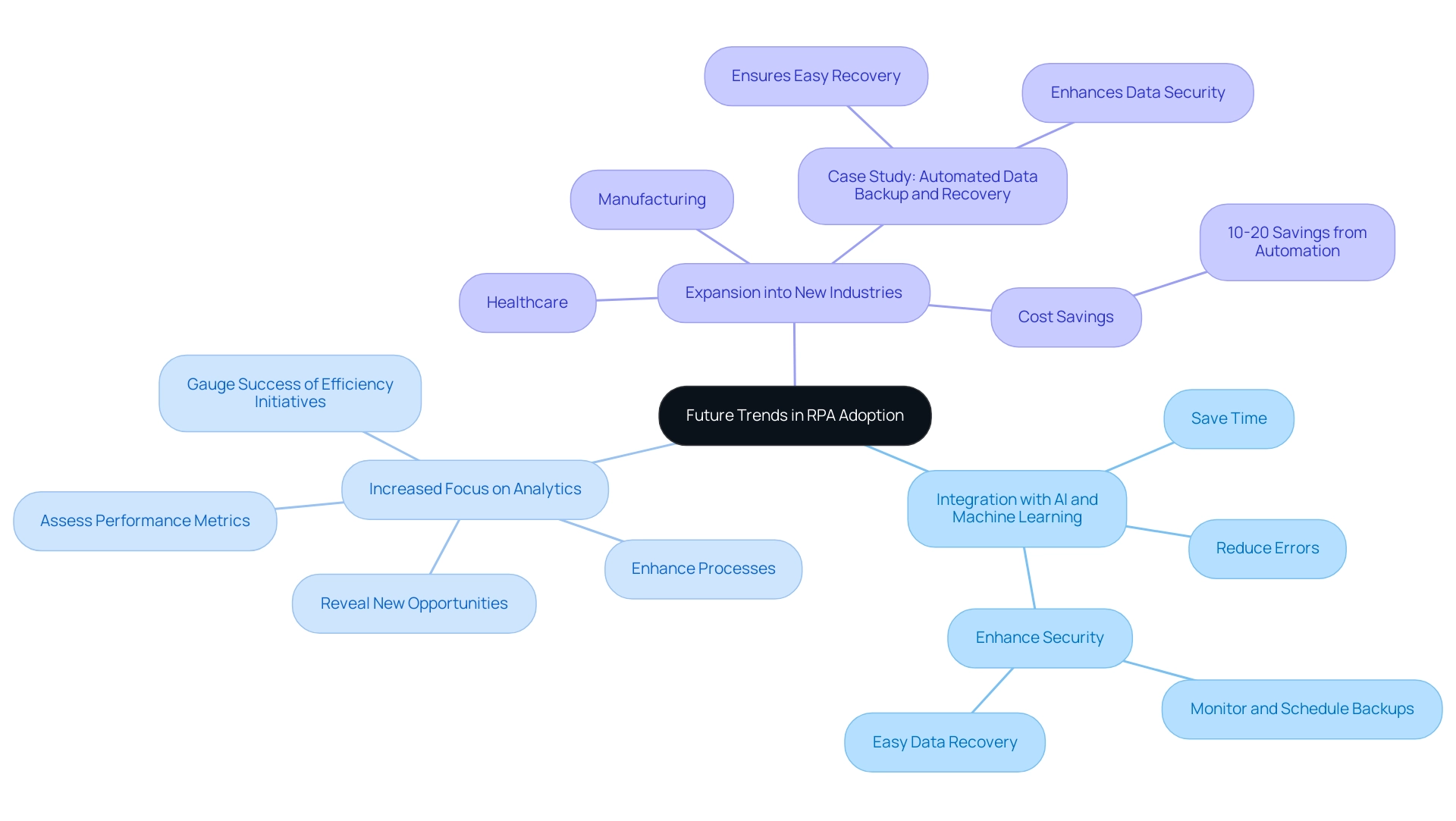
Conclusion
Robotic Process Automation (RPA) is reshaping the operational landscape for businesses across various sectors, offering significant advantages in efficiency, accuracy, and cost reduction. By automating repetitive tasks such as data entry, invoice processing, and customer service inquiries, organizations can not only streamline their workflows but also free up valuable employee time for more strategic initiatives. The integration of tailored AI solutions further enhances RPA’s capabilities, enabling deeper insights and better decision-making.
The transformative use cases of RPA, particularly in IT, finance, and customer service, highlight its versatility and effectiveness. From automating data migration and incident management in IT to revolutionizing invoice processing and expense management in finance, the benefits are clear. These improvements not only lead to substantial operational efficiencies but also empower organizations to adapt to ever-changing market demands and regulatory requirements.
As businesses look to the future, the continued integration of RPA with AI and machine learning will unlock even greater potential, driving innovation and operational excellence. With a growing focus on analytics and expansion into new industries, the adoption of RPA is set to become a cornerstone of competitive advantage. Embracing this technology will position organizations to thrive in an increasingly automated world, making it essential for leaders to prioritize RPA as a strategic initiative for sustained growth and success.

